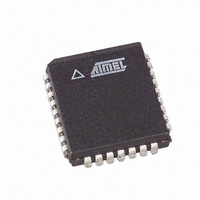AT49LH002-33JC Atmel, AT49LH002-33JC Datasheet - Page 10

AT49LH002-33JC
Manufacturer Part Number
AT49LH002-33JC
Description
IC FLASH 2MBIT 33MHZ 32PLCC
Manufacturer
Atmel
Datasheet
1.AT49LH002-33JC.pdf
(36 pages)
Specifications of AT49LH002-33JC
Format - Memory
FLASH
Memory Type
FLASH
Memory Size
2M (256K x 8)
Speed
33MHz
Interface
Parallel
Voltage - Supply
3 V ~ 3.6 V
Operating Temperature
0°C ~ 85°C
Package / Case
32-PLCC
Lead Free Status / RoHS Status
Contains lead / RoHS non-compliant
Available stocks
Company
Part Number
Manufacturer
Quantity
Price
FWH Write Cycle
Figure 3. FWH Write Cycle
Table 5. FWH Write Cycle
Note:
10
FWH4/LFRAME
Clock Cycle
FWH/LAD[3:0]
3 - 9
10
11
12
13
14
15
16
17
1
2
1. Field contents are valid on the rising edge of the present clock cycle.
CLK
AT49LH002
Field Name
MADDR
RSYNC
START
MSIZE
IDSEL
TAR0
TAR1
TAR0
TAR1
DATA
DATA
1110b
START
1
IDSEL
IDSEL
FWH write cycles are used to send commands to the device and to program data into the
memory array.
Valid FWH write cycles begin with a START field of 1110b being sent to the device. Following
the IDSEL, MADDR, and MSIZE fields, the master sends one byte of data to the FWH device
during the next two clock cycles. The data is sent one nibble at a time with the low nibble being
output first followed by the high nibble. After the data has been sent, the master will send a
2-clock TAR field to the FWH device to indicate that it is turning control of the LPC bus back
over to the FWH. After the second clock of the TAR phase, the FWH device assumes control
of the bus and drives a “ready” SYNC field to verify that it has received the data. The FWH
device will then send a 2-clock TAR field to the master to indicate that it is turning control of
the bus back over to the master.
2
(indicates 1 byte)
0000b to 1111b
A27-A24 A23-A20 A19-A16
FWH/LAD[3:0]
Field Value
0000b (ready)
1111b (float)
1111b (float)
3
1110b
0000b
1111b
1111b
YYYY
YYYY
YYYY
4
(1)
5
Float then OUT
FWH/LAD[3:0]
OUT then float
Float then IN
A15-A12
MADDR
IN then float
Direction
OUT
6
IN
IN
IN
IN
IN
IN
A11-A8
7
A7-A4
Comments
FWH4/LFRAME must be active (low) for the device to respond. Only
the last START field (before FWH4/LFRAME transitioning high) should
be recognized. The START field contents indicate a FWH memory
write cycle.
Indicates which FWH memory device should respond. If the IDSEL field
matches the strapping values on ID[3:0], then that particular device will
respond to subsequent commands.
These seven clock cycles make up the 28-bit memory address. YYYY
is one nibble of the entire address. Addresses are transferred with the
most significant nibble first.
The MSIZE field indicates how many bytes will be transferred. The
device only supports single-byte operations, so MSIZE must be 0000b.
YYYY is the least significant nibble of the data byte. The data byte is
either any valid Flash command or the data to be programmed into the
memory array.
YYYY is the most significant nibble of the data byte.
In this clock cycle, the master has driven the bus to all 1s and then
floats the bus prior to the next clock cycle. This is the first part of the bus
“turn-around cycle”.
The device takes control of the bus during this clock cycle.
During this clock cycle, the device will generate a “ready” SYNC
indicating that the data byte has been received.
The FWH memory device drives the bus to 1111b to indicate a turn-
around cycle.
The FWH memory device floats its outputs, and the master regains
control of the bus during this clock cycle.
8
A3-A0
9
0000b
MSIZE
10
D3-D0
DATA
11
D7-D4
DATA
12
1111b
TAR0
13
High-Z
TAR1
14
RSYNC
0000b
15
3377B–FLASH–9/03
1111b
TAR0
16
High-Z
TAR1
17















